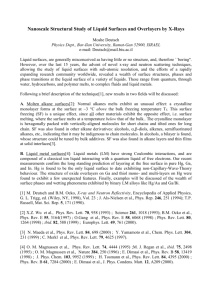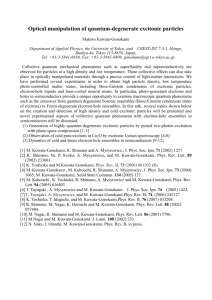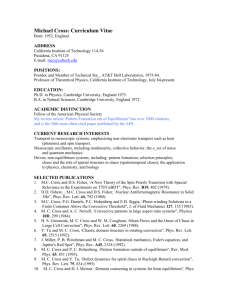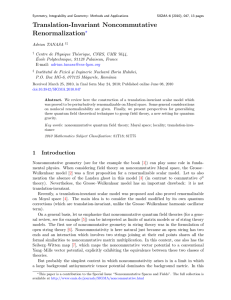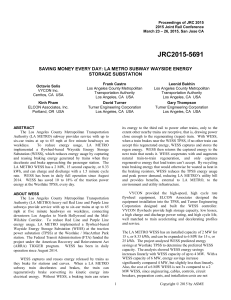Theoretical Physics Division
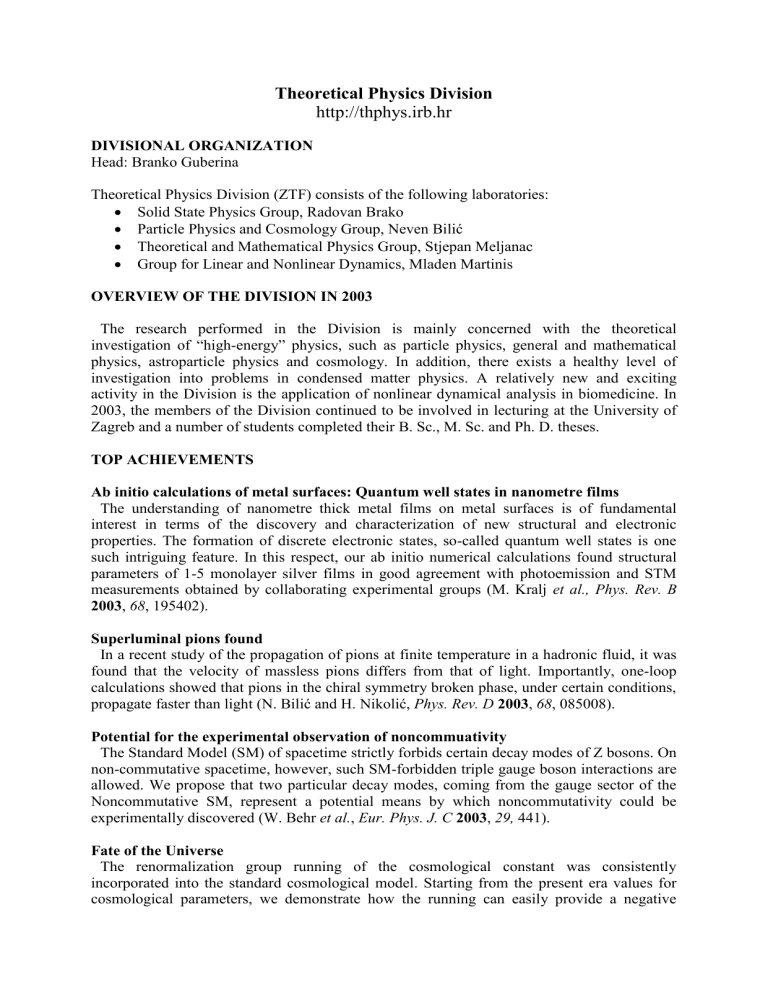
Theoretical Physics Division
DIVISIONAL ORGANIZATION
Head: Branko Guberina
http://thphys.irb.hr
Theoretical Physics Division (ZTF) consists of the following laboratories:
Solid State Physics Group, Radovan Brako
Particle Physics and Cosmology Group, Neven Bilić
Theoretical and Mathematical Physics Group, Stjepan Meljanac
Group for Linear and Nonlinear Dynamics, Mladen Martinis
OVERVIEW OF THE DIVISION IN 2003
The research performed in the Division is mainly concerned with the theoretical investigation of “high-energy” physics, such as particle physics, general and mathematical physics, astroparticle physics and cosmology. In addition, there exists a healthy level of investigation into problems in condensed matter physics. A relatively new and exciting activity in the Division is the application of nonlinear dynamical analysis in biomedicine. In
2003, the members of the Division continued to be involved in lecturing at the University of
Zagreb and a number of students completed their B. Sc., M. Sc. and Ph. D. theses.
TOP ACHIEVEMENTS
Ab initio calculations of metal surfaces: Quantum well states in nanometre films
The understanding of nanometre thick metal films on metal surfaces is of fundamental interest in terms of the discovery and characterization of new structural and electronic properties. The formation of discrete electronic states, so-called quantum well states is one such intriguing feature. In this respect, our ab initio numerical calculations found structural parameters of 1-5 monolayer silver films in good agreement with photoemission and STM measurements obtained by collaborating experimental groups (M. Kralj et al., Phys. Rev. B
2003 , 68 , 195402).
Superluminal pions found
In a recent study of the propagation of pions at finite temperature in a hadronic fluid, it was found that the velocity of massless pions differs from that of light. Importantly, one-loop calculations showed that pions in the chiral symmetry broken phase, under certain conditions, propagate faster than light (N. Bilić and H. Nikolić, Phys. Rev. D 2003 , 68 , 085008).
Potential for the experimental observation of noncommuativity
The Standard Model (SM) of spacetime strictly forbids certain decay modes of Z bosons. On non-commutative spacetime, however, such SM-forbidden triple gauge boson interactions are allowed. We propose that two particular decay modes, coming from the gauge sector of the
Noncommutative SM, represent a potential means by which noncommutativity could be experimentally discovered (W. Behr et al.
, Eur. Phys. J. C 2003 , 29, 441).
Fate of the Universe
The renormalization group running of the cosmological constant was consistently incorporated into the standard cosmological model. Starting from the present era values for cosmological parameters, we demonstrate how the running can easily provide a negative
cosmological constant thereby changing the fate of the universe. Interestingly, the running also renders compatibility with critical string theory (B. Guberina et al.
, Phys. Rev. D 2003 ,
67, 083001).
Unified approach to the representations of QM on noncommutative space
We presented a unified approach to the representations of quantum mechanics on noncommutative spaces. As a demonstration of the utility of the approach we have applied it to both the two dimensional harmonic oscillator and the Landau problem (L. Jonke and S.
Meljanac, Eur. Phys. J. C 2003 , 29 , 433).
Modeling Chronic Lymphocytic Leukaemia (CCL)
As a result of extensive modelling, we conclude that CLL occurs as a consequence of agedependent, genetically related functional restrictions of the thymic microenvironment in supporting common lymphoid progenitor cells (B. Vitale et al.
, Scan. J. of Immun.
2003, 58 ,
588).
SELECTED INVITED LECTURES
1.
B. Melić, "LCSR analysis of exclusive two-body B decays", invited plenary talk at 3rd
International Workshop on B physics and CP violation (BCP3), Taipei, Taiwan, 29.9.-1.10.2003.
2. K. Passek-Kumerički, "Hard exclusive processes and higher-order QCD corrections", invited talk given at the 9th Adriatic Meeting, Dubrovnik, Croatia, 4-14.9.2003.
3.
B. Melić, "Estimate of Charming Penguins in B → pi pi" , invited talk given at International
Europhysics Conference on High Energy Physics EPS, Aachen, Germany, 17-23.7.2003.
4. B. Melić, "Some aspects of charmless B decays from QCD light-cone sum rules", invited plenary talk at the International conference Flavor Physics & CP Violation, FPCP 2003, Ecole
Polytechnique, Paris, France, 3-6.6.2003.
5. J. Trampetić, "Phenomenology of Noncommutative Gauge Theory", invited lecture at the workshop JULIUS WESS DAYS 2003, Noncommutativity: From Mathematics to
Phenomenology, Bayrischzell, Germany, 2-5.5.2003.
6. B. Melić, "Charming penguins in B → pi pi from QCD light-cone sum rules", invited talk, CKM
Workshop, 2nd Meeting, IPPP Durham, United Kingdom, 5-9.4.2003.
INTERNATIONAL CONFERENCES ORGANIZED BY SCIENTISTS OF THE DIVISION
9 th Adriatic Meeting (Central European Symposia) – Particle Physics and the Universe, Dubrovnik,
Croatia, 4-14.9.2003., Chairmen: Josip Trampetić, Julius Wess.
See also: “Lecture Notes in Physics: Particle Physics in the New Millennium”, Proceedings of the 8 th
Adriatic Meeting, J. Trampetić, J. Wess (Eds.)
PROJECTS
Projects supported by the Ministry of Science and Technology (MZT)
1. Physics of surfaces, microstructures and strongly correlated systems, Radovan Brako
2. Fundamental interactions in elementary particle physics and cosmology, Branko Guberina
3. Quantum field theory, noncommutative spaces, and symmetries, Stjepan Meljanac
4. Structure of dynamical fluctuations in nonlinear systems, Mladen Martinis
Collaborative projects
1.
Radovan Brako: Participation in collaborative project “Nanosciences: A way towards new technologies”, MZT, December 2003. Project leader: Dr. M. Milun, Institute of Physics, Zagreb.
2. Kornelija Passek-Kumerički, collaboration beetwen Ruđer Bošković Institute, Theoretical Physics
Division and Institut für Theoretische Physik II, Bochum, Germany, DFG project “Higher-order
QCD corrections in exclusive processes-mesons and baryons”.
3. M. Martinis: Research in self organization and organization of molecules in supramolecules, complexes, macromolecules, and supermolecular structures. Coordinator: N. Filipović-
Vinceković, and I. Jalšenjak, Faculty of Pharmacy and Pharmaceutical Biochemistry, Zagreb.
SELECTED PUBLICATIONS
M. Kralj, P. Pervan, M. Milun, P. Lazić, Ž. Crljen, R. Brako, J. Schneider, A. Rosenhahn, K. Wandelt,
“Tetragonal silver films on V(100): Experimental and ab initio studies” Phys. Rev. B 2003 , 68 ,
195402.
Ž. Crljen, P. Lazić, D. Šokčević, R. Brako, “Relaxation and reconstruction on (111) surfaces of Au, Pt, and Cu” Phys. Rev. B 2003 , 68 , 195411.
N. Bilić, H. Nikolić, “Superluminal pions in a hadronic fluid”, Phys. Rev. D 2003 , 68 , 085008.
B. Melić, D. Müller, K. Passek-Kumerički, “Next-to-next-to-leading order prediction for the photonto-pion transition form factor” Phys. Rev. D 2003 , 68, 014013.
W. Behr, N.G. Deshpande, G. Duplančić, P. Schupp, J. Trampetić, J. Wess, “The Z →
, gg decays in the non-commutative standard model” Eur. Phys. J. C 2003 , 29, 441.
B. Guberina, R. Horvat, H. Štefančić, “Renormalization-group running of the cosmological constant and the fate of the universe” Phys. Rev. D 2003 , 67, 083001.
L. Jonke, S. Meljanac, “Representations of non-commutative quantum mechanics and symmetries”
Eur. Phys. J. C 2003 , 29 , 433.
S. Meljanac, M. Mileković, A. Samsarov, “A multispecies Calogero model” Phys Lett. B 2003 , 573 ,
202.
M. Dimitrijević, L. Jonke, L. Möller, E. Tsouchnika, J. Wess, M. Wohlgenannt, “Deformed field theory on
-spacetime” Eur. Phys. J. C 2003 , 31 , 129.
B. Vitale, M. Martinis, M. Antica, B. Kušić, S. Rabatić, A. Gagro, R. Kušec, B. Jakšić,
“Prolegomenon for Chronic Lymphocytic Leukaemia” Scan. J. of Immun.
2003, 58 , 588.



